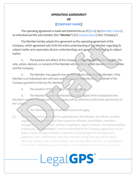Remote Work Policies: Operating Agreement Updates for Distributed Teams
Remote work has become an integral part of many businesses. It offers flexibility and can lead to higher productivity. However, without the right...
4 min read
LegalGPS : Feb. 25, 2025
Running a business with a partner can be rewarding but also challenging. You share ideas, responsibilities, and profits. However, disagreements can arise, leading to deadlock situations where no decision can be made. This can stall progress and harm the business.


Legal GPS Pro
Protect your business with our complete legal subscription service, designed by top startup attorneys.
Deadlock happens when partners cannot agree on important decisions, leading to a standstill. It's essential to have a plan in place to resolve these disputes before they become major problems. Having clear dispute resolution clauses in your partnership agreement can help prevent and resolve deadlocks.
In this article, we will discuss how to understand deadlock in partnerships, the essential components of dispute resolution clauses, and effective strategies for crafting these clauses. This knowledge helps you keep your business running smoothly, even when disagreements occur.
Deadlock in partnerships occurs when partners cannot agree on important business decisions. This situation creates a standstill, stopping the business from moving forward. Deadlocks can be caused by many issues, such as disagreements on spending, strategies, or management decisions.
Recognizing the signs of potential deadlock can help you address issues early. Clear communication and regular meetings can also help partners stay aligned. However, having a formal plan in place, like dispute resolution clauses, is the best way to handle deadlocks effectively.
Dispute resolution clauses outline how to handle disagreements in a partnership. Including these clauses in your partnership agreement can prevent deadlocks and ensure smooth operations. Here are the key components to include:
By including these components, you create a structured approach to resolving disputes. This helps prevent deadlocks from stalling your business and ensures both partners have a clear path to resolution.

Attorney-Drafted LLC Operating Agreement
Get a customizable, attorney-drafted LLC Operating Agreement built for legal protection.
Trusted by 1,000+ businesses to safeguard their LLCs.
Creating a robust strategy to prevent deadlock is pivotal for the success of a partnership. Here are some effective methods to consider:
Implementing these strategies ensures that partners can resolve issues quickly and keep the business moving forward smoothly.


Legal GPS Pro
Protect your business with our complete legal subscription service, designed by top startup attorneys.
Once you have crafted your dispute resolution clauses, it's crucial to implement and review them regularly to ensure they work effectively.
By implementing and reviewing these clauses regularly, you can ensure they remain effective and relevant.

Attorney-Drafted LLC Operating Agreement
Get a customizable, attorney-drafted LLC Operating Agreement built for legal protection.
Trusted by 1,000+ businesses to safeguard their LLCs.
Deadlock in partnerships can halt progress and create significant challenges. However, by understanding the roots of deadlock, incorporating essential dispute resolution clauses, and crafting effective prevention strategies, you can mitigate these risks. Clear documentation, regular communication, and training are key components to ensure your dispute resolution process functions smoothly.
Regularly reviewing and updating your partnership agreement is crucial. This not only helps you adapt to new challenges but also reinforces the partnership's stability and growth. Consistently applying these practices ensures a harmonious work environment where disputes are resolved swiftly and fairly.
Turning these strategies into practice can seem daunting, but you’re not alone. Legal GPS is here to help guide you through the legal intricacies, ensuring your partnership operating agreement is thorough and effective. Visit Legal GPS today to safeguard your business against potential deadlocks and foster a productive partnership.
The biggest question now is, "Do I need a lawyer for an Operating Agreement?” For most businesses and in most cases, you don't need a lawyer to start your business. Instead, many business owners rely on Legal GPS Pro to help with legal issues.
Legal GPS Pro is your All-In-One Legal Toolkit for Businesses. Developed by top startup attorneys, Pro gives you access to 100+ expertly crafted templates including operating agreements, NDAs, and service agreements, and an interactive platform. All designed to protect your company and set it up for lasting success.

Legal GPS Pro
Protect your business with our complete legal subscription service, designed by top startup attorneys.
| Premium Template Single-use Template |
Legal GPS Pro Unlimited Access, Best Value |
|
|
| Choose Template | Learn More |
| Trusted by 1000+ businesses | |

Remote work has become an integral part of many businesses. It offers flexibility and can lead to higher productivity. However, without the right...

Capital contribution conflicts can cause serious trouble for any LLC. These conflicts arise when members disagree about how much money or assets each...

Creating an S Corp operating agreement is essential for protecting your business and ensuring smooth operations. While basic provisions cover some...